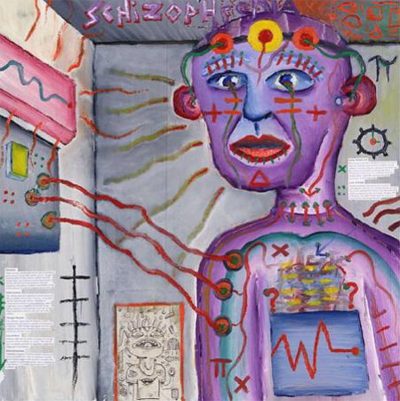Psychosis
Most of you have probably had the experience of walking down the street in a city and seeing a person you thought was acting oddly. They may have been dressed in an unusual way, perhaps disheveled or wearing an unusual collection of clothes, makeup, or jewelry that did not seem to fit any particular group or subculture. They may have been talking to themselves or yelling at someone you could not see. If you tried to speak to them, they may have been difficult to follow or understand, or they may have acted paranoid or started telling a bizarre story about the people who were plotting against them. If so, chances are that you have encountered an individual with schizophrenia or another type of psychotic disorder.

Schizophrenia is a devastating psychological disorder that is characterized by major disturbances in thought, perception, emotion, and behavior. About 1% of the population experiences schizophrenia in their lifetime, and usually the disorder is first diagnosed during early adulthood (early to mid-20s). Schizophrenia and the other psychotic disorders are some of the most impairing forms of psychopathology, frequently associated with a profound negative effect on the individual’s educational, occupational, and social function. Sadly, these disorders often manifest right at time of the transition from adolescence to adulthood, just as young people should be evolving into independent young adults.
The spectrum of psychotic disorders includes schizophrenia, schizoaffective disorder, delusional disorder, schizotypal personality disorder, schizophreniform disorder, brief psychotic disorder, as well as psychosis associated with substance use or medical conditions. Even when they receive the best treatments available, many with schizophrenia will continue to experience serious social and occupational impairment throughout their lives. In the United States, the cost of schizophrenia, including direct costs (e.g., outpatient, inpatient, drugs, and long-term care) and non-health care costs (e.g., law enforcement, reduced workplace productivity, and unemployment) was estimated to be $62.7 billion in 2002.
The main symptoms of schizophrenia include hallucinations, delusions, disorganized thinking, disorganized or abnormal motor behavior, and negative symptoms (APA, 2013). A hallucination is a perceptual experience that occurs in the absence of external stimulation. Auditory hallucinations (hearing voices) occur in roughly two-thirds of patients with schizophrenia and are by far the most common form of hallucination (Andreasen, 1987). The voices may be familiar or unfamiliar, they may have a conversation or argue, or the voices may provide a running commentary on the person’s behavior (Tsuang, Farone, & Green, 1999).
Delusions are false beliefs that are often fixed, hard to change even when the person is presented with conflicting information, and are often culturally influenced in their content (e.g., delusions involving Jesus in Judeo-Christian cultures, delusions involving Allah in Muslim cultures). They can be terrifying for the person, who may remain convinced that they are true even when loved ones and friends present them with clear information that they cannot be true. There are many different types or themes to delusions.
Positive Symptoms
Talking to someone with schizophrenia is sometimes difficult, as their speech may be difficult to follow, either because their answers do not clearly flow from your questions, or because one sentence does not logically follow from another. This is referred to as disorganized speech, and it can be present even when the person is writing. Disorganized behavior can include odd dress, odd makeup (e.g., lipstick outlining a mouth for 1 inch), or unusual rituals (e.g., repetitive hand gestures).
Negative Symptoms
Some of the most debilitating symptoms of schizophrenia are difficult for others to see. These include what people refer to as negative symptoms or the absence of certain things we typically expect most people to have. For example, anhedonia or amotivation reflect a lack of apparent interest in or drive to engage in social or recreational activities. These symptoms can manifest as a great amount of time spent in physical immobility. Importantly, anhedonia and amotivation do not seem to reflect a lack of enjoyment in pleasurable activities or events (Cohen & Minor, 2010; Kring & Moran, 2008; Llerena, Strauss, & Cohen, 2012) but rather a reduced drive or ability to take the steps necessary to obtain the potentially positive outcomes (Barch & Dowd, 2010). Flat affect and reduced speech (alogia) reflect a lack of showing emotions through facial expressions, gestures, and speech intonation, as well as a reduced amount of speech and increased pause frequency and duration.
Cross-Cultural Considerations
It is clear that there are important genetic contributions to the likelihood that someone will develop schizophrenia, with consistent evidence from family, twin, and adoption studies. (Sullivan, Kendler, & Neale, 2003) but there is no such thing as the schizophrenia gene. It is more likely that the genetic risk for schizophrenia reflects the summation of many different genes that each contribute something to the likelihood of developing psychosis (Gottesman & Shields, 1967; Owen, Craddock, & O’Donovan, 2010). Further, schizophrenia is a very heterogeneous disorder, which means that two different people with schizophrenia may each have very different symptoms (e.g., one has hallucinations and delusions, the other has disorganized speech and negative symptoms).
About 0.3% to 0.7% of people are affected by schizophrenia during their lifetimes. In 2013 there were an estimated 23.6 million cases globally. Males are more often affected, and on average experience more severe symptoms. About 20% of people eventually do well and a few recover completely, while about 50% have lifelong impairment. Social problems, such as long-term unemployment, poverty and homelessness, are common. The average life expectancy of people with the disorder is ten to twenty-five years less than for the general population. This is the result of increased physical health problems and a higher suicide rate (about 5%). In 2015 an estimated 17,000 people worldwide died from behavior related to, or caused by, schizophrenia. There is also a higher than average suicide rate associated with schizophrenia.
The term for schizophrenia in Japan was changed from “mind-split disease” to “integration disorder,” to reduce stigma. The new name was inspired by the biopsychosocial model and as a result the percentage of people who were informed of the diagnosis increased from 37 to 70% over three years. A similar change was made in South Korea in 2012. A professor of psychiatry, Jim van Os, has proposed changing the English term to “psychosis spectrum syndrome”.

Individuals with severe mental illness, including schizophrenia, are at a significantly greater risk of being victims of both violent and non-violent crime. Schizophrenia has been associated with a higher rate of violent acts, but most appear to be related to substance abuse. Media coverage relating to violent acts by individuals with schizophrenia reinforces public perception of an association between schizophrenia and violence.

